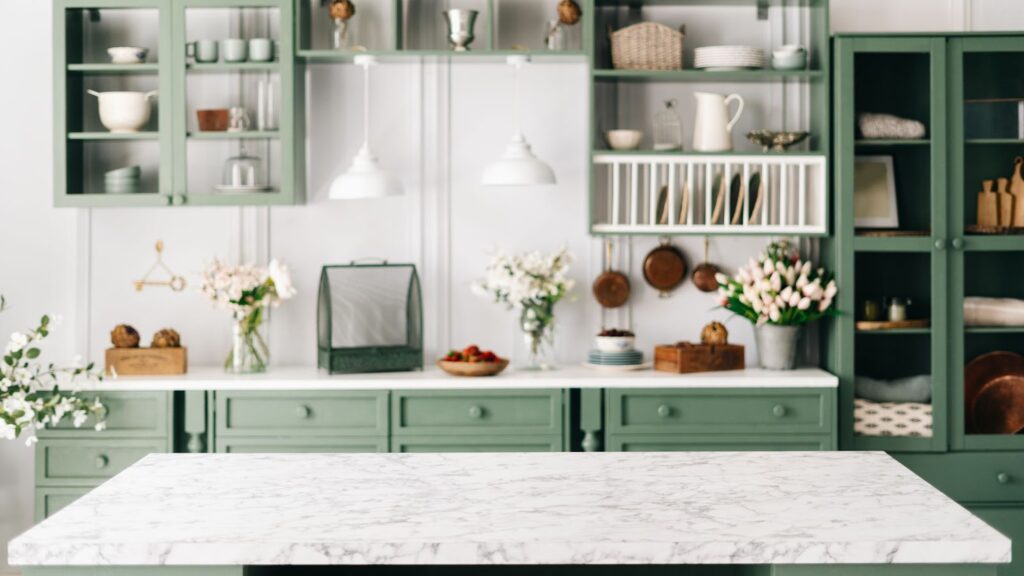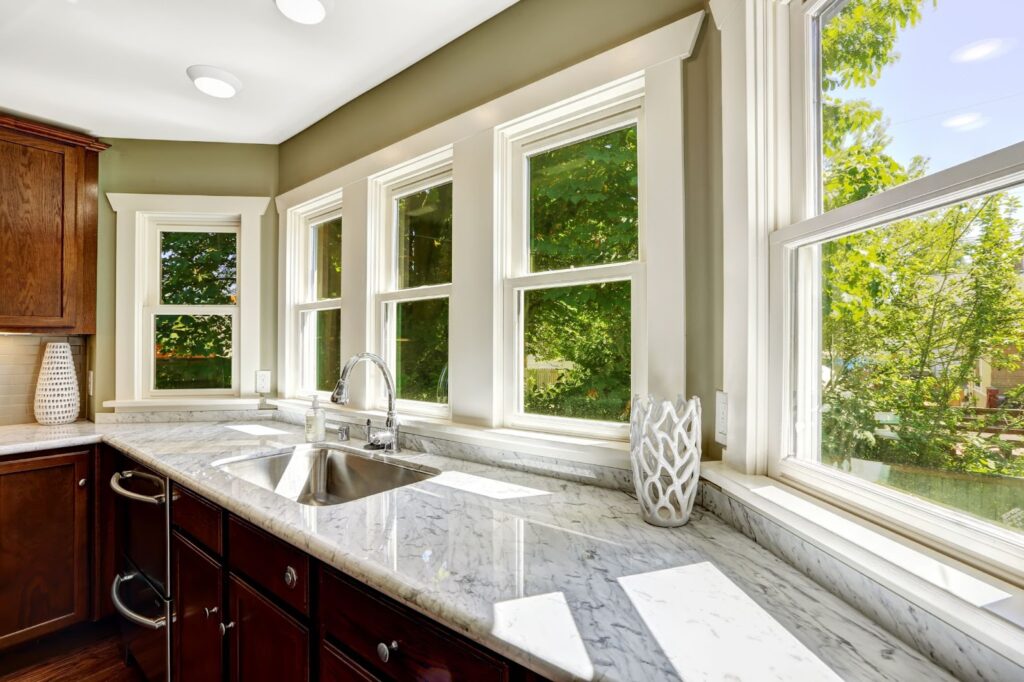Marble countertops bring timeless elegance and natural beauty to any space, but they also require a bit of extra care, especially when it comes to stains. Because marble is a porous stone, it’s more susceptible to absorbing liquids and developing discoloration if spills aren’t cleaned up promptly.
Fortunately, with the right approach, you can safely and effectively remove most of the stain without damaging the surface.
In this complete guide, we’ll walk you through everything you need to know about how to effectively remove stains from marble countertops. Keep reading to learn more.
Why does marble stain?
Marble countertops are prized for their natural beauty and timeless elegance, but they are also more delicate than many homeowners realize. One of the most common concerns is their tendency to stain. Understanding why this happens is the first step toward effective stain removal.
About marble
Marble is a porous natural stone with tiny holes and channels within its structure that may absorb liquids and oils. When spills are left on the surface, especially from acidic or pigmented substances like wine, coffee, or cooking oil, those liquids can seep into the stone and cause discoloration. This is what we commonly refer to as staining.
Staining vs. etching
Additionally, it’s important to distinguish between stains and etching. A stain changes the color of the marble, while etching refers to a dull mark caused by acidic substances reacting with the calcium carbonate in the stone. Etching often resembles a stain, but requires a different approach to correct.
Addressing stains
The good news is that most stains on marble countertops can be addressed with the right marble stain remover and some basic knowledge. Regular sealing helps reduce the stone’s absorbency and prevents many common stains from taking hold.
However, when stains do happen, prompt action and proper stain removal techniques are essential to preserve the look and longevity of your marble surface.

Common types of marble stains and their causes
Marble countertops are vulnerable to a variety of stains. Each stain has a different cause and appearance, which determines how it should be treated.
Oil-based stains
Oil-based stains are among the most common, typically caused by substances like cooking oils, butter, lotion, or greasy foods. These stains often appear as darker spots on the surface and may leave a slightly greasy texture.
Because marble is porous, oils easily seep into the stone and cause discoloration from within, especially around cooktops or food prep areas.
To remove these stains, create a poultice using baking soda and water and apply it directly to the stain. Cover the area with plastic wrap, tape down the edges, and let it sit for 24–48 hours. Once dry, gently wipe it away with a soft cloth. You may need to repeat the process for deeper stains.
Organic stains
Organic stains come from naturally pigmented materials like coffee, tea, wine, fruit juice, condiments, leaves, and flowers. Depending on the source, these stains usually appear as brown, pink, yellow, or reddish discoloration.
Since organic materials contain strong pigments, they quickly soak into the stone and leave behind visible marks, particularly in kitchens and outdoor spaces.
For these stains, use a mixture of 12% hydrogen peroxide and a few drops of ammonia. Apply it to the stained area with a soft cloth or a cotton ball, allow it to sit for a few minutes (no longer than necessary), then rinse thoroughly with water and dry. Take care with this method on darker marble, as peroxide can slightly lighten the stone.
Rust stains
Rust stains occur when metal objects such as cans, utensils, or tools are left on marble surfaces for extended periods. When moisture is present, it causes the metal to oxidize, transferring rust onto the stone. These stains are typically orange, brown, or yellow in color and often appear in the shape of the object that caused them.
These can be tricky to remove without professional help, but some rust removers are safe for marble. Make sure the product is labeled specifically for use on natural stone. Apply it as directed, avoiding scrubbing or scraping, and always test in a small area first.
Ink and dye stains
Ink and dye stains are also a concern, especially in bathrooms and workspaces. Items like pens, markers, hair dye, or pigmented cleaning products can leave behind dark or brightly colored stains. Light-colored marble is especially susceptible, as the pigments get absorbed quickly and may become difficult to remove without proper treatment.
Ink stains from pens or markers and dye stains from colored liquids or personal care products can be difficult to remove.
You can use hydrogen peroxide applied with a soft cloth for light-colored marble.
For darker marble, use acetone instead. Dab the solution onto the stain, let it sit for a few minutes, then wipe clean and rinse with water. Repeat as needed, but avoid excessive use as it may affect the stone’s finish.
Water spots and rings
Lastly, water spots and rings are subtle but common issues. They are caused by hard water, glasses, and dishes left on the countertop. The minerals in the water leave behind cloudy spots, white rings, or dull marks that build up over time, particularly if the marble is not properly sealed.
To treat them, clean the area with a soft cloth and a marble-safe cleaner. If the marks persist, buff the surface gently with a dry microfiber cloth or apply a marble polishing powder according to the manufacturer’s instructions.

General principles for stain removal
Before diving into specific stain removal methods, it’s important to understand a few general principles that apply to treating any type of stain on marble countertops. These tips will help you approach stain removal effectively while protecting your marble’s delicate surface.
Act quickly
The sooner you address a spill or stain, the better your chances of removing it completely. Marble’s porous nature means that liquids can soak in and discolor the stone if left untreated. Immediate action can prevent deeper staining and reduce the need for aggressive cleaning methods.
Blot, don’t rub
When dealing with a fresh spill, always blot with a soft cloth or paper towel rather than rubbing, as rubbing may spread the stain or push it further into the surface. Press the cloth over the area to soak up as much liquid as possible before applying any cleaning solution.
Use pH-neutral cleaners
Avoid acidic or harsh chemical cleaners, such as vinegar, lemon juice, bleach, or ammonia, which can damage the marble’s surface and cause etching.
Instead, opt for pH-neutral cleaners that are specifically designed for natural stone. These will safely break down the stain without compromising the countertop’s integrity.
Test in a small area first
Before using any stain removal method or marble stain remover, test it on a small, inconspicuous area of your countertop. This ensures that the solution won’t damage or discolor the stone, especially if you’re using hydrogen peroxide, acetone, or commercial products.
Be patient and repeat as needed
Some stains may require more than one treatment to entirely disappear. Many DIY solutions, like poultices or mild peroxide applications, need to sit for 24 to 48 hours and may need to be reapplied. Patience and consistency are key to safely removing stains without damaging your marble.
Seal your marble regularly
Finally, prevention is the best defense. Sealing your marble countertops every six to 12 months helps create a barrier against stains, making them easier to clean and less likely to set in.
Contact Intermountain Stone & Marble today
If you’re ready to restore the beauty of your marble countertops — or thinking about upgrading to marble for the first time — Intermountain Stone & Marble is here to help. From expert stain removal advice to premium stone selection and professional installation, our team will help you protect and enhance your investment.
Whether you need maintenance support or are exploring design options for your kitchen or bath, we offer the knowledge, materials, and craftsmanship to bring your vision to life.
Contact Intermountain Stone & Marble today to speak with one of our experts or visit our showroom to explore our stunning marble selections in person. Let us help you keep your countertops as beautiful and timeless as the day they were installed.


